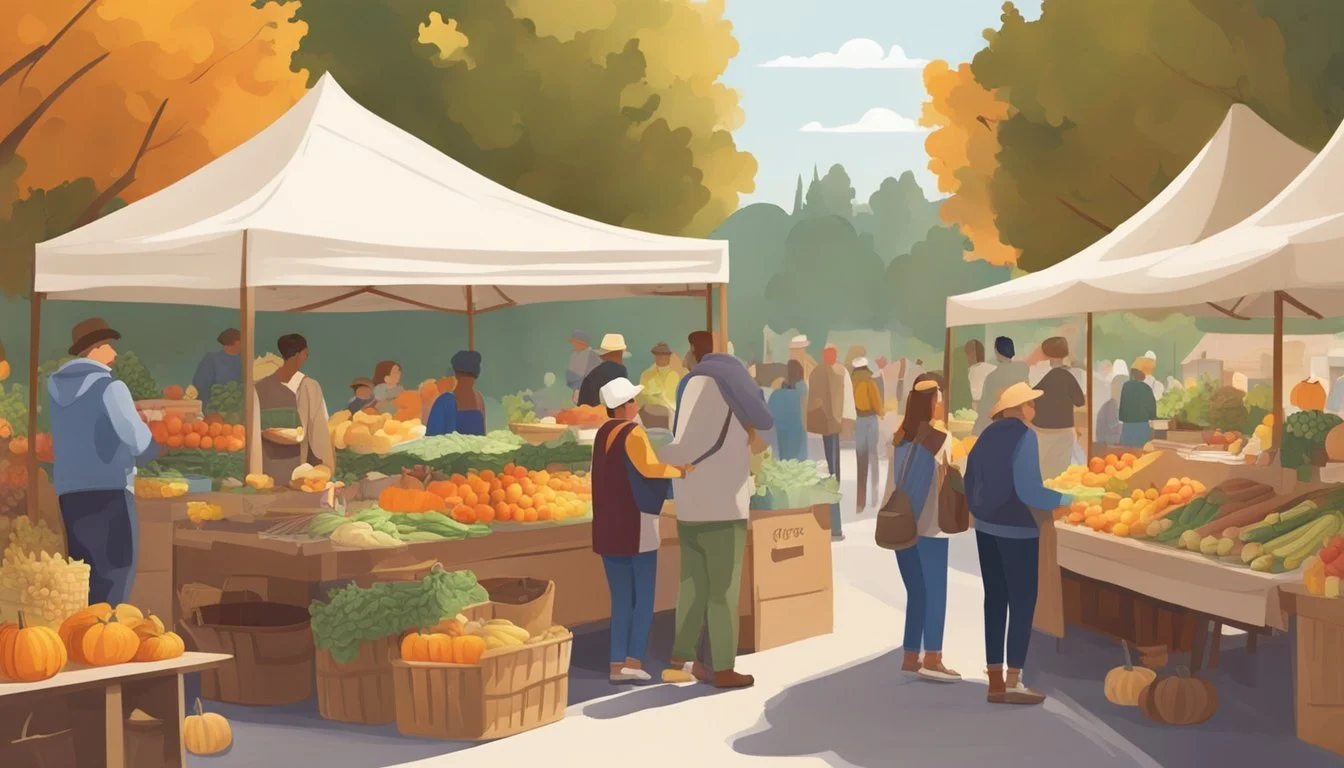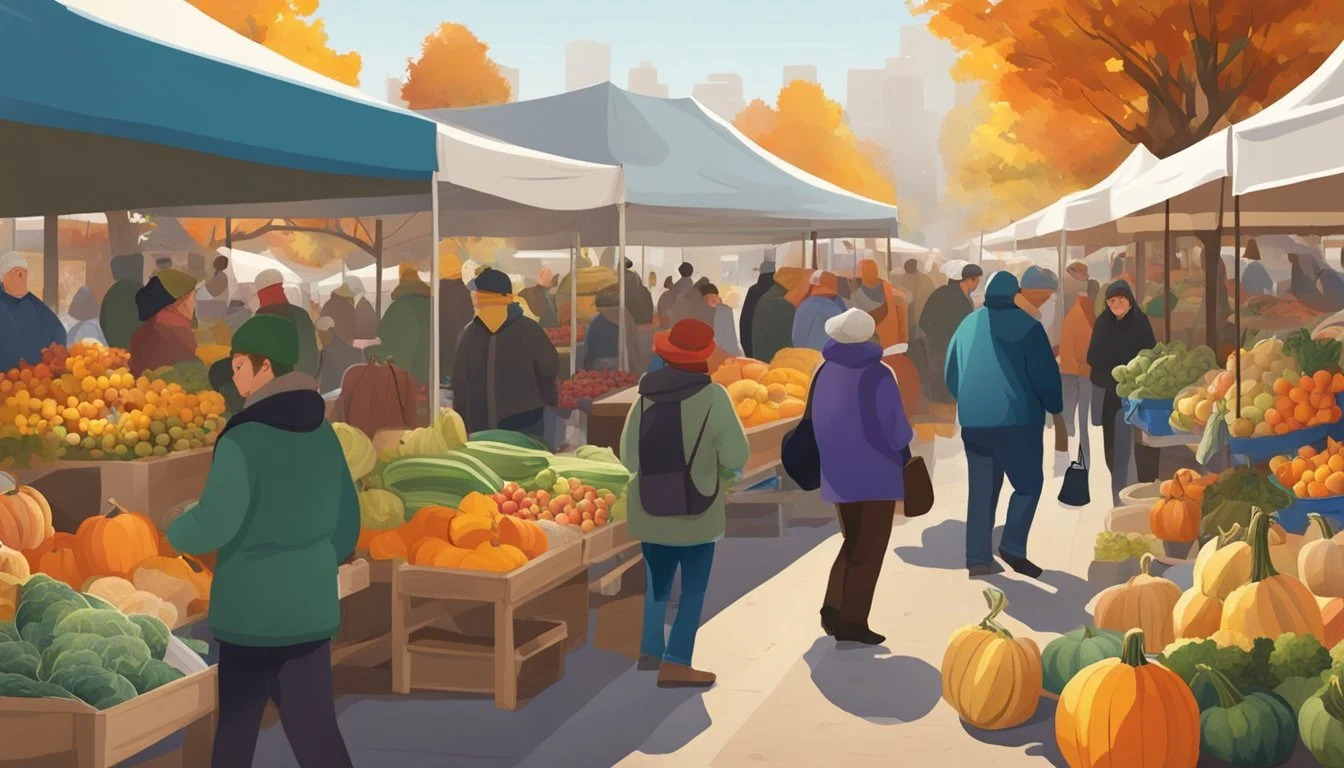The Best Farmers' Market Finds for Autumn and Winter
Seasonal Picks for Hearty Meals
As the leaves change colors and the crisp air sets in, autumn ushers in a season of plentiful harvests at local farmers' markets. They become vibrant hubs for seasonal produce, offering an array of fruits and vegetables that epitomize the tastes of fall. Apples, a staple of the season, come in numerous varieties, each with its own flavor and texture profile, perfect for both eating fresh and incorporating into autumnal recipes. Pumpkins and squashes also make a striking presence, with their rich, earthy flavors (What wine goes well with earthy flavors?) ideal for both sweet and savory dishes.
Transitioning into winter, farmers' markets adapt to the colder weather, but they don't dwindle in their offerings. Root vegetables such as carrots, beets, and potatoes maintain a steady presence, known for their ability to be stored and enjoyed throughout the winter months. These hardy vegetables become the base for warm, comforting meals that are synonymous with the season. Greens like swiss chard and kale, along with mushrooms and a range of citrus fruits, provide a boost of nutrition and flavor even as the days grow shorter.
For those seeking fresh, local produce throughout autumn and winter, farmers' markets continue to be a valuable source. Supporting local farmers and enjoying the freshest ingredients available often leads to more nutritious meals, helping individuals make the most of the season's bounty. Whether it's transforming a pumpkin into a creamy soup or adding a crunch to a salad with a fresh apple, the cooler seasons offer an abundance of possibilities for anyone looking to embrace the flavors of the market's local produce.
Why Shop at Farmers' Markets in Autumn and Winter
Shopping at farmers' markets during autumn and winter supports local farmers and contributes positively to the community and local economy. Unlike supermarkets, where produce may travel thousands of miles, farmers' markets typically offer goods from the region. This shorter distance from farm to table not only reduces the carbon footprint but ensures buyers receive fresh, seasonal produce.
Autumn brings a bounty like:
Pumpkins
Squash
Apples
Root vegetables
While winter offers:
Cold storage produce (potatoes, onions)
Hydroponic greens
Sustainably produced meat, eggs, and dairy
These markets provide produce that is often at the peak of its flavor due to seasonal growth cycles. Local produce tends to retain more nutrients since it is fresher, having been harvested more recently than its supermarket counterparts.
Moreover, shopping at farmers markets during these seasons strengthens the economy by keeping money within the community and supporting local farmers who might otherwise struggle in the off-peak seasons. It fosters a relationship between consumer and grower, creating a more interconnected community.
It's not just about the fresh goods; it's also the experience of embracing seasonal changes and participating in local traditions that define regional cuisine and culture. Whether it is the vibrant colors of fall vegetables or the hearty greens of winter, farmers' markets offer a unique and enriching shopping experience in every season.
Seasonal Fruits to Look For
In autumn and winter, farmers' markets are treasure troves of nutrient-rich fruits with a variety of flavors. Consumers should take advantage of the seasonal offerings to enjoy fresh produce that may also provide health benefits such as fiber and vitamin C.
Apples and Pears
Apples: A staple of fall, apples offer a variety of flavors from sweet to tart. Customers will find an array of types, including Honeycrisp, Gala, and Granny Smith, which are perfect for both eating raw and for culinary uses.
Pears: Pears, like apples, come in multiple varieties such as Bartlett, Bosc, and Anjou. They are known for their soft, buttery texture and are best enjoyed when fully ripe. Both apples and pears are high in dietary fiber.
Citrus and Cranberries
Citrus Fruits: As the weather cools, citrus fruits come into season. Varieties like oranges, grapefruits, and tangerines become widely available, offering a refreshing burst of vitamin C.
Cranberries: Tart and vibrant, cranberries are commonly found in markets during the fall. Their unique flavor profile enhances both savory and sweet dishes, and they are often celebrated for their antioxidant properties.
Exotic and Storage Fruits
Exotic Fruits: Farmers' markets may also feature exotic fruits that are in season, such as persimmons or pomegranates. These fruits add a special touch to the seasonal palette with their distinctive tastes and textures.
Storage Fruits: Some fruits, like apples, pears, and quinces, can be stored and enjoyed throughout the winter months if kept in proper conditions. This allows for a prolonged enjoyment of autumn's harvest.
Top Vegetables to Buy
As autumn chill sets in, farmers' markets offer a vibrant selection of nutritious vegetables sure to enhance any meal. Shoppers will find a variety of flavor-rich produce that packs both nutritional value and fiber.
Hearty Greens and Squashes
Kale and other greens thrive in cooler weather, becoming sweeter as the temperature drops. High in nutrients, kale is a versatile choice for salads, soups, and sautéed dishes. (What Wine Pairs Best with Sautéed Dishes) The farmers' markets also boast an array of winter squashes, from butternut to acorn, known for their rich, sweet flavor and hearty texture. These squashes are excellent sources of fiber and can be roasted, pureed for soups, or incorporated into warm salads.
Kale: Ideal for crispy chips or wilted into stews.
Winter Squash: Best roasted or in soups; keeps well long-term.
Root Vegetables and Cruciferous Delights
Root vegetables like carrots, beets, parsnips, and turnips offer deep earthy flavors and are packed with nutrition and fiber. These root vegetables can be roasted to concentrate their natural sweetness or used in hearty stews and casseroles. Cruciferous vegetables, such as brussels sprouts and cauliflower, also make their seasonal appearance, bringing texture and robust flavor to dishes. They shine when roasted or steamed and can be seasoned in a variety of ways to complement their unique tastes.
Carrots & Beets: Sweet and earthy, great for roasting or juicing.
Fennel & Cabbage: Anise-flavored fennel and versatile cabbage are crisp and flavorful.
Cauliflower & Brussels Sprouts: Best for roasting; rich in flavor and ideal for absorbing spices.
These vegetables not only elevate the flavor profile of meals but also contribute to a well-rounded, fiber-rich diet.
Unique Finds for the Cooler Months
Farmers' markets in autumn and winter are brimming with specialty produce that offers rich flavors and culinary diversity. Shoppers can explore and support local farmers who provide an array of unique items perfect for the season.
Specialty Mushrooms and Tubers
Mushrooms: In the cooler months, markets often feature a variety of mushrooms that are sought after for their earthy flavors and textures. Shoppers may find choices such as shiitake, oyster, and lion's mane - each offering distinct tastes and benefits for autumnal dishes.
Tubers: Markets may also be flooded with tubers like sweet potatoes and Jerusalem artichokes. (What wine goes well with artichokes?) These items not only bring sweetness and heartiness to meals but are also versatile in preparation, whether roasted, mashed, or used in soups.
Heirloom Varieties and Ferments
Heirloom Varieties: Farmers' markets are treasure troves for heirloom produce such as apples, squashes, and pumpkins. The flavors they provide surpass common supermarket varieties and are often more nutritionally diverse due to their unique genetics and farming practices.
Ferments: Patrons should look out for local ferments like sauerkraut. These fermented foods (What wine goes well with fermented foods?) enrich dishes with complex flavors and offer health benefits associated with probiotics. They're made by local artisans who often use time-honored techniques to create these flavorful accompaniments.
The Splendor of Fresh Herbs and Spices
When the colder seasons approach, farmers' markets transition to offering robust herbs and warming spices that not only please the olfactory senses but also add depth to autumn and winter dishes.
Fresh Herbs for Flavor
Farmers' markets during autumn are abundant with fresh herbs (how long do fresh herbs last?) that add a burst of flavor to any dish. Parsley and sage bring a savory earthiness, ideal for incorporating into holiday stuffing or savory pies. Thyme, with its subtle, dry aroma, complements root vegetables splendidly. These herbs become staples for enriching the flavors of seasonal cooking.
Herb Pairings for Culinary Use:
Basil: complements tomato-based dishes
Cilantro: enhances the flavor of Asian and Mexican dishes
Mint: adds freshness to beverages and desserts
Rosemary: pairs well with roasted meats (What wine goes well with roasted meats?) and potatoes
Autumn Spices for Warmth
The spices found at farmers' markets in the latter part of the year are synonymous with warmth and comfort. Cinnamon is perhaps the most quintessential autumn spice, finding its way into beverages, desserts, and savory dishes alike. It promises a sweet, woody flavor that is unmistakable in apple pies and cinnamon rolls. Nutmeg offers a slightly nutty warmth, perfect for sprinkling on top of frothy drinks or mashed sweet potatoes. Let's not forget ginger, a versatile spice that imparts a fiery zest to dishes and can be used in both its fresh and ground form.
Popular Autumn Spices:
Spice Common Uses Cinnamon Pies, mulled drinks, oatmeal Nutmeg Eggnog, sweet potato casseroles Ginger Gingerbread, pumpkin pie, teas
Benefits of Eating Seasonally
Eating seasonally during autumn and winter provides numerous benefits that extend beyond the simple pleasure of enjoying fresh produce at its peak. The fruits and vegetables harvested within these seasons are often more nutritious due to being picked at the optimal time for both flavor and nutrient content.
Healthier Choices: Seasonal fruits and vegetables are fresher and, therefore, typically retain more vitamins and minerals than produce that is shipped long distances. Consuming these foods can contribute to a healthier diet.
Supports Soil: When farmers plant and harvest crops in alignment with their natural cycle, it helps protect the soil's quality and biodiversity. Healthy soils produce more nutritious crops.
Peak Freshness: Vegetables and fruits in season are fresher and taste better. They do not undergo long transportation or unnecessary storage, which can diminish flavor and freshness.
Harvest Season Variety: Autumn and winter offer a range of fresh produce exclusive to these months, encouraging diversity in one's diet. Pumpkins, squash, apples, and root vegetables are among the common harvest season finds.
Consumers who choose seasonal items often enjoy the benefits of eating food that aligns with the body's natural nutritional needs for the time of year. Fresh autumn and winter produce can be heartier and provide the energy necessary during the cooler months.
By opting for seasonal foods, shoppers not only get to savor the taste and reap the health advantages but also contribute positively to the environment by reducing the carbon footprint associated with transporting non-seasonal foods over great distances.
Supporting Local Agriculture
When consumers purchase directly from local farmers at farmers' markets, they're investing in more than just fresh produce. Local agriculture thrives on community support; each transaction offers tangible benefits to the local economy and the hard work of farmers.
Local farmers often employ sustainable practices, minimizing the environmental impact. These agricultural professionals commit to long hours and intense labor to yield the high-quality goods found at farmers' markets. Customers have the opportunity to engage in the products' stories, from how the food was grown to the varieties available.
Investing in local agriculture also stimulates the local economy. Dollars spent at farmers' markets circulate within the community, bolstering the financial stability of the area. This cycle propels:
Job creation for residents
Financial support for small-scale and mid-sized farms
Opportunities for farmers to innovate and expand
Additionally, communities benefit through:
Increased access to nutritious, fresh food
Support for a diversified local food supply
Local farmers' markets act as social hubs, fostering connections within the community. They provide a space for residents to meet the individuals behind their food, creating a sense of trust and companionship.
In conclusion, by supporting local farmers, consumers can help create a robust local economy, contribute to the sustainability of farming practices, and nurture the heart of the community.
Farmers' Market Shopping Tips
When one shops at the farmers market during the autumn and winter, they have the opportunity to select from an array of fresh produce while supporting the local community. Knowing how to choose the best produce and making the most of the market visit can significantly enhance the experience and benefit their health.
How to Choose the Best Produce
The key to choosing the best produce is examining the freshness and ripeness. For autumn, one should look for firm pumpkins with intact stems, crisp apples with no soft spots, and root vegetables like turnips and beets that are heavy for their size. In winter, quality citrus should feel heavy for their size, indicating juiciness, and winter greens like kale should not have any yellowing leaves.
Apples: Firm to the touch; bright, consistent color.
Pumpkins: Smooth, consistent skin; sturdy stem still attached.
Root Vegetables: Firm and heavy; no signs of shriveling.
Making the Most of Your Market Visit
To make the most of a market visit, it's beneficial to go early to have the first pick of fresh items or to go late when vendors are more likely to discount produce to clear their stock. They should always bring small change to facilitate easier transactions. Conversations with farmers can provide insights into the produce, such as tips for storage and preparation. They should not be afraid to ask vendors about how to prepare unfamiliar items.
Arrival Time: Early for selection, late for deals.
Cash: Small denominations for convenience.
Vendor Interaction: Ask questions to learn about new items and receive preparation tips.
By following these strategies, shoppers can enjoy high-quality produce and enrich their shopping experience at the farmers market.





